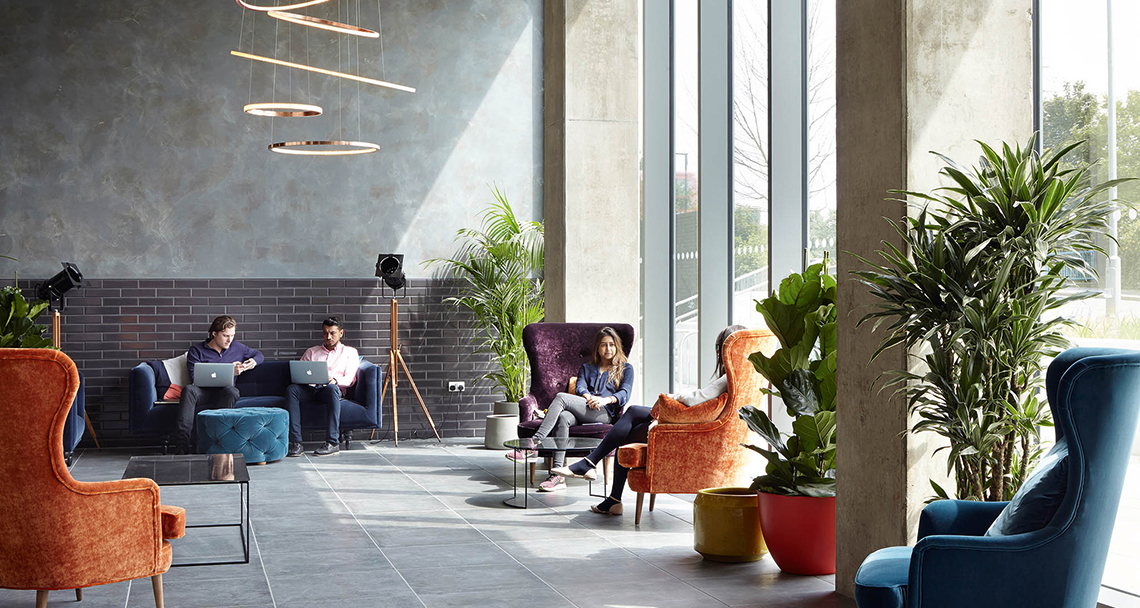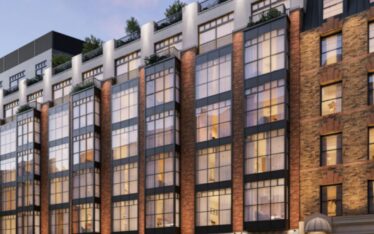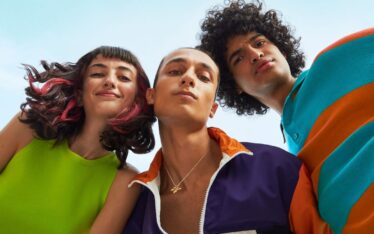Hybrids are dynamic, multifunctional spaces where people can stay, work, eat, drink and socialise, all under one roof.
With a number of different elements encompassed under one brand, a hybrid hotel is appealing to several guest segments each with their own motivations and interests. But, how do you reach them?
Personalise, personalise, personalise.
Personalisation is key to getting the right message in front of the right person in the right place at the best time. Personalising your communications has been proven to improve brand perception and guest experience, grow user engagement, boost bookings and increase marketing spend efficiency by 10–30%.
It’s also a great way of getting ahead of your competitors – many in the industry simply aren’t getting it right, with less than 50% of consumers feeling that travel brands send them relevant communications that they would actually engage with. Yet it’s what your target audience want and expect, with 86% stating they are more likely to purchase from a brand who provides personalised experiences online.
So, if you’re thinking about using personalisation to boost your hybrid hotel’s revenue, check out our tips below…
STRATEGY
Before you begin personalising your marketing to reach your specific target audiences, you need to know who you actually want to reach.
Once you are clear on this, it’s time to set out tactics outlining how you will reach, engage and convert your target audiences. To help you achieve this, we recommend creating at least one guest persona – which are data-based fictional profiles of your guests – for each segment you are targeting.
These personas will form the foundation of your personalisation strategy and will help you to determine your marketing messaging and methods. The goal is to make your target audiences feel you are speaking directly to them through your marketing.
You can download our free guest persona template here – feel free to drop us a message if you have any questions about filling this out.
EMAIL MARKETING
Email is one of the most powerful and cost effective tools through which to reach your audience. It’s also one of the best tools for personalisation. On average, people check their inbox 15 times a day and – according to Adestra – people prefer email for communicating with the brands they’re connected with.
We all know that general ‘send-to-all’ mailers are becoming increasingly less successful, with 63% people stating they find it ‘highly annoying’. This is because – as we’ve explained above – people are now expecting a personalised email experience. In order for your email marketing to be effective, you need to take the time to map out a solid strategy, segment your audiences and develop clear messaging.
SEGMENTING YOUR EMAIL AUDIENCE
Segmenting your email list ensures you are sending relevant information to the people on your mailing list based on their information, interactions and experiences with you. From simply splitting your database into upcoming guests and past guests to creating lists based on a user’s behaviour or location, this tactic creates huge opportunities to boost bookings and increase revenue.
i) SEGMENTING BY PRE + POST STAY
When guests book to stay with you directly, it gives you the ideal opportunity to personalise their experience via email. Think of it like an extension of your customer service that begins before guests arrive at your reception to check in.
Based on the information you have from their booking, send personalised pre-stay emails with additional experiences or amenities you offer that you think they would enjoy during their time with you. By providing relevant and valuable information, you are building the foundations of a loyal relationship with your guests as well as increasing revenue from creating up-selling opportunities.
Communicating with your guests isn’t over once they have checked out either. Going beyond the typical post-stay mailer of encouraging reviews, sending relevant content to those who have previously stayed with you is an effective way to turn past guests into loyal brand ambassadors. For example, you could send an email to a past guest with a limited-time offer on accommodation or an experience they previously had with you to encourage a return visit. This speaks directly to them as an individual and the exclusivity ensures they will feel valued as a previous visitor.
You can easily automate these processes through your PMS or email service provider – drop us a message if you’re looking for support in this area.
ii) SEGMENTING BY LOCATION
Of course, your hybrid has multiple revenue streams with multiple audiences, some of whom will not stay with you. Segmenting based on a user’s location allows you to send tailored content to locals who are more likely to use and engage with your space to work and socialise. It also ensures you are not sending irrelevant information to people who live outside of the country you are located in and therefore avoiding users unsubscribing.
Sharing news and offers related to your bar, restaurant and programming to your local email list increases the likelihood of them taking actions such as making a reservation, booking a ticket to an event and creating plans at your space with their peers.
iii) SEGMENTING BY USER’S BEHAVIOUR
Using email automation with your segmentation strategy is a great way to send relevant and timely emails to prospective customers based on the actions they have taken on your website.
For example, if someone downloads your local guide to the neighbourhood from your site, you can create an email funnel which will send them related information. This provides you with the opportunity to deliver more value and build a relationship with the user, which will no doubt influence their decision to visit you.
WEBSITE
People have increasingly high expectations of hotel websites these days. Gone are the days where looking pretty and loading quickly is enough. Your website now needs to look the part, act the part and reflect your target markets personal needs and preferences. Your target markets want to feel seen and valued – personalising your website is a great way to fulfil this need.
To start personalising your site, you need to get smart with the data you collect. Review your user flows through Google Analytics to map the journey a customer takes through your site and to see where users drop off. Based on how a user behaves on your site, you can customise the browsing experience they have in order to boost conversions. For example, if the user has visited the web page of your coworking space previously, you could automate a popup with an exclusive % off membership discount to encourage signups on their return visit.
To improve your website conversion rate and turn browsers into bookers, you can also personalise the site experience based on the user’s lifecycle stage. You could do this by setting up a pop-up with a ‘you’re back!’ limited time direct booking offer for returning visitors who have already demonstrated booking intent.
While personalising your website is an effective way of boosting both bookings and revenue, it needs to be done in a way that provides value to the user with a clear strategy in mind. If not, you risk bombarding your site’s visitors with irrelevant content. For example, you wouldn’t want a first time visitor to your website to be immediately shown direct booking offer pop-ups as there is little chance they will immediately book when they have only just discovered your brand. This could lead the user to feel fed up with the generalised sales messaging and leave the site. However, if you are selective with where you place pop-ups (in terms of pages and timing), you will achieve a much better result.
LANDING PAGES
Creating bespoke landing pages is a great way to personalise your marketing and improve your conversion rate. They allow you to target specific guest segments and offer them something of real value.
While the main body of your website is built for any potential guest of yours to find general information, landing pages have a narrower, more targeted focus.
Landing pages can be used across your marketing and in your paid ads. We recommend using landing pages in both your retargeting ads and email marketing campaigns because the user has already shown an interest in your brand. You will have also already captured information based on who they are, where they’re located and what they’re interested in.
For example, if a potential guest has engaged with a paid social ad about weekend activities and experiences they could have when staying at your site, you could target them with a landing page that has a relevant direct booking offer. This could be something along the lines of ‘Book a weekend stay with us and get your third night free’. Whatever you decide on, the deal needs to offer something that is genuinely valuable to the user in order to drive bookings.
Simplicity is key here. It’s important to ensure you have one clear call to action and do not clutter your landing page with a variety of information that will distract your potential guests. By directing the user’s attention to a landing page that focuses on a specific action, the likelihood of converting their interest into a confirmed booking increases.
PAID ADVERTISING
In our blog post on how to market a hybrid hotel, we talked about the effectiveness of creating separate ad funnels for each of your target markets.
Creating separate ad funnels is a powerful tactic to reach the right kind of people with the right kind of content which, in turn, will increase conversions as well as the return on your ad spend.
Your funnels should include multiple ad sets and ads to guide your potential customers through the booking journey. Ads can be personalised to a specific target market by a number of factors including interests, behaviours, age and location. Use your guest personas to inform your ad copy and content.
You could also utilise the powerful Lookalike Audiences took which allows you to create an audience with similar characteristics to one of your current audiences e.g. your Instagram followers or web visitors.
You can personalise further by creating retargeting ads using custom audiences made up of users who have already visited your site or engaged with your content, but not yet booked with you. Whether it be a local who has engaged with an ad about your onsite restaurant or a potential guest who has browsed specific pages on your site, you can retarget those who have shown an interest with hyper relevant offers and content.
Remember – the more relevant, the better. In fact, 79% consumers say they are only likely to engage with an offer on an ad if it has been personalised to reflect previous interactions they have had with the brand.
i) FACEBOOK HOTEL ADS
For the accommodation element of your hybrid, you could set up Facebook Hotel Ads. Facebook Hotel Ads offers hotels a way to reach different audiences at various stages in their booking process with customised messages. These ads can deliver a high return on investment by boosting direct bookings.
Hotel Ads uses dynamic retargeting ads which vary from standard retargeting because they allow you to target users with ads based on their potential stay dates, the room types they have browsed and more – personalisation at its very best.
CONTENT MARKETING
As we’ve said many times before, having an active blog on your site is a great way to boost your SEO, produce shareable content for your other marketing platforms and bring more potential guests to your website. When you go one step further, it can also be a tool for better personalisation.
When it comes to topics for your blog, it’s worth taking the time to think more deeply about who the intended recipients of each article are, rather than creating general content for anyone and everyone. Once again, your guest personas will help you with this task.
Once you’ve created tailored blog content for each guest segment, you will be able use it across your email and social media platforms. It will also enable you to retarget users who have visited particular blog posts with relevant ads (as we described in the last section). This will help to develop a relationship with your potential guests and nurture them along the customer purchase journey, until they are ready to book.
The more tailored the content is, the more effective it will be in increasing web traffic, building brand loyalty and boosting both bookings and revenue.
DATA
If you are familiar with our content, you will know there is rarely a blog post that goes by in which we don’t talk about data – and for good reason. Not only is it the most accurate tool for determining how your marketing is performing, it is absolutely key in getting results when it comes to personalisation. Successful personalisation is achieved through data collection, analysis and digital automation. So, if you weren’t already using your data to level up your brand’s marketing, it’s time to begin.
Utilising the data you have at your fingertips will help you to learn more about your target market’s interests, habits and behaviours which can inform your guest personas, strategy and content.
Across your PMS, Google Analytics, social media and email insights, there is a wealth of information we recommend reviewing regularly and analysing on at least a monthly basis. At the click of a button, you can find out where your web traffic is coming from, which content is driving the most traffic to your site and what direct booking offer codes are being used most frequently – all valuable insight into how your marketing is working.
Using Ads Manager, we recommend checking insights such as reach, unique link clicks and website purchases on a frequent basis in order to review what ads are performing the best in terms of conversions.
When it comes to your email marketing campaigns, be sure to review the open and click through rate of your funnels on a regular basis to ensure that the content is resonating with your audience segments – and more importantly, converting.
Data-driven personalisation allows you to deliver a great guest experience, improving the likelihood of them returning to your space (and therefore increasing the lifetime value of the guest).
Although it is important for people that their information is used securely online (and with their permission), 63% of millennials say they are willing to share their data in order to receive personalised offers and a meaningful marketing experience. It’s vital for your brand’s marketing success to use it.
Our industry is one of community and experiences – that’s why it’s so effective to use the data and technology you have at your fingertips to enhance the guest experience without replacing the personalised human touch that your target markets are looking for.
If you are looking for support with personalising your brand’s marketing, get in touch and let’s chat about how we can help you.

DOWNLOAD OUR WHITE PAPER – THE FUTURE OF HOSPITALITY: WHY 2021 IS THE YEAR OF THE HYBRID
Looking forward to 2021, the lines between where we live, work, and play are blurring faster than ever before. As people demand more from the hospitality experience, hybrids are in a strong position to meet this new consumer where they are.
In this white paper, we share our 6 predictions on why 2021 will be the year of the hybrid. We also have interviews with leaders in this space who share their insights on the future of the industry.



